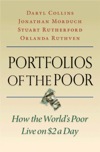Portfolios of the Poor: Financial diaries of the bottom billion
by Daryl Collins, Jonathan Morduch, Stuart Rutherford, Orlanda Ruthven
Princeton University Press
Hardcover, May 2009
Abstract
About forty percent of the world’s people live on incomes of two dollars a day or less. If you’ve never had to survive on an income so small, it is hard to imagine. How would you put food on the table, afford a home, and educate your children? How would you handle emergencies and old age? Every day, more than a billion people around the world must answer these questions. Portfolios of the Poor is the first book to explain systematically how the poor find solutions.
The authors report on the yearlong “financial diaries” of villagers and slum dwellers in Bangladesh, India, and South Africa–records that track penny by penny how specific households manage their money. The stories of these families are often surprising and inspiring. Most poor households do not live hand to mouth, spending what they earn in a desperate bid to keep afloat. Instead, they employ financial tools, many linked to informal networks and family ties. They push money into savings for reserves, squeeze money out of creditors whenever possible, run sophisticated savings clubs, and use microfinancing wherever available. Their experiences reveal new methods to fight poverty and ways to envision the next generation of banks for the “bottom billion.”
“The unbanked do not have access to such luxuries as standing orders, which richer people use to overcome the temptation to spend whatever they earn. And they are forced to pay for things that are free for most—which enables women like Jyothi to earn a crust by offering a safe store for small savings. But with some ingenuity, they use unorthodox financial instruments to create a more stable life than their erratic incomes would otherwise allow.”
“Often times in the development community the bottom billion is thought of in terms of aggregate statistics without much attention given to the individuals and their day to day lives. The goal of the authors was to find a happy medium between aggregate data/statistics and individual anthropological research. What they developed as a result were Financial Diaries, which give a basic overview of every financial transaction made and service used over the studied timeframe.
Through the use of Financial Diaries, the researchers meticulously tracked every detail of their subjects’ financial lives by interviewing them bi-weekly for one year using metrics of the portfolio management world, including cash flow and income statement analysis. While gathering evidence, they discovered that it took approximately six interviews with each respondent to develop the trust required to obtain accurate data and account for margins of error. This is in interesting implication for research that is often times based on one interview. Their analysis approached households as start-up organizations and adjusted their research using these metrics.”





[…] VÃa | Putting People First […]